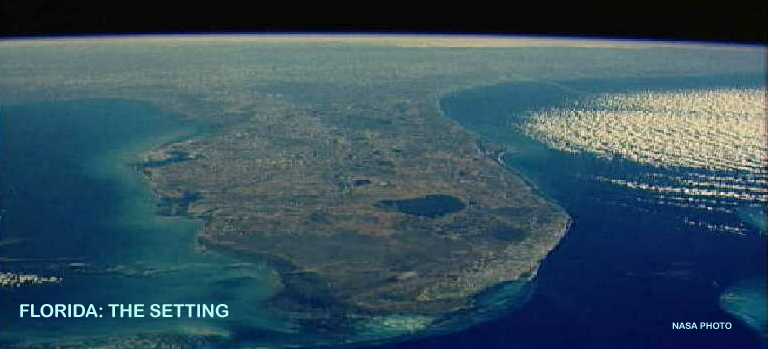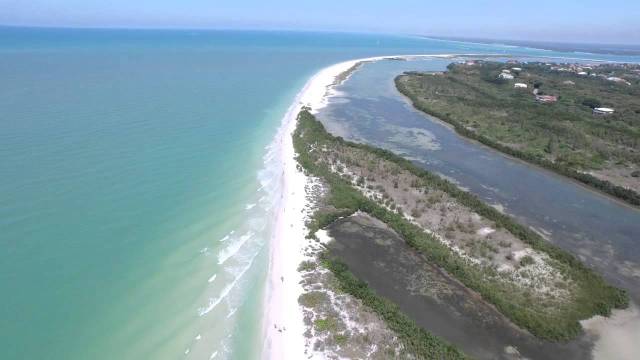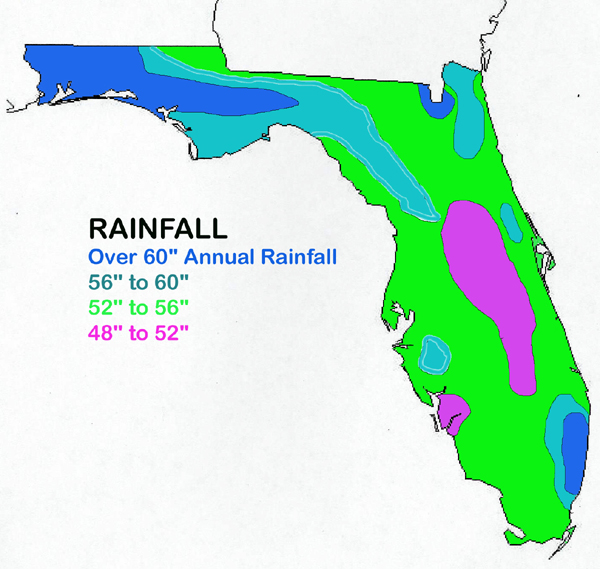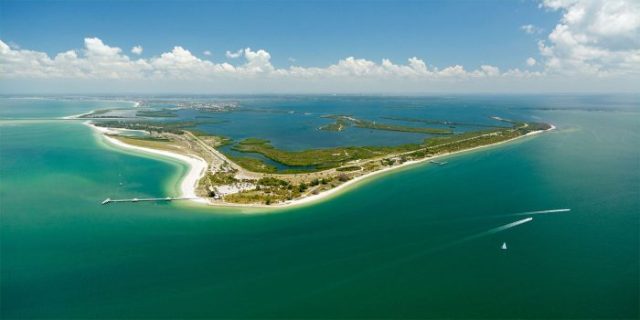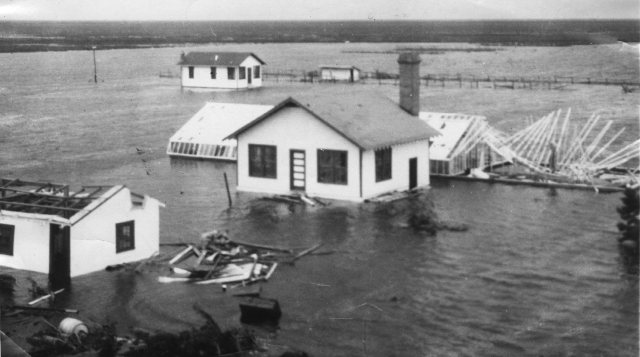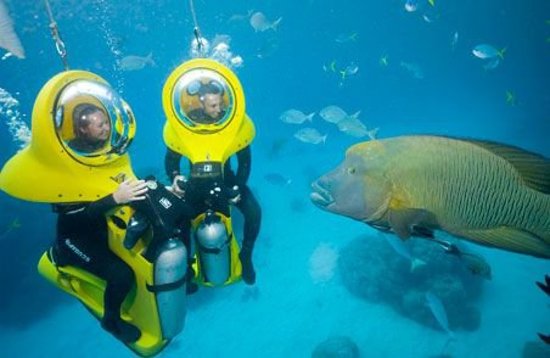As Neil Armstrong returned to Earth from his historic walk
on the Moon, the first place in the United States
he noticed was appropriately Florida,
the spot where his mission started. Sticking out into the Gulf of Mexico and
Atlantic Ocean in the southeast corner of the country, Florida is just so identifiable. The
peninsular was just such a landmark to the Spanish conquistadors who viewed Florida as the front door to their great American Empire
and to the beginning of North America.
After 200 million years, when dinosaurs roamed the land, these volcanic
mountains eroded leaving a shallow sea where was once the Trench. Masses of
sand and fossilized marine shell, called limestone, formed mounting layers of
this underwater plateau. These layers finally arched upward to create a marshy
plain at sea level, where fossilized bones and shells caused phosphate deposits.
During the Ice Age, one million years ago, the waters of the world filled
into glaciers, thus lowering the level of the oceans. Florida grew to twice its present size.
Saber-toothed tigers and mastodons roamed the cool swamplands of Florida. When the ice
melted, the oceans again rose and cut Florida
into terraces and upland plateaus.
In recent geologic history, sandbars have extended the coastline while coral
grew along the warm waters. Coral, the skeletal deposits of dead sea life of
anthozoan family, protected the southern shores from some erosion. Men made the
other drastic land changes by closing off the natural flow of waters in great
tidal marshes, by cutting down forest cover, and by filling in many bays and
river inlets.
Today, Florida
has six major geographic regions that historians utilize to describe
regions:
The Coastal Lowlands encircle the state and extend along the shores
inland from ten to one hundred miles. The most recent region to emerge from the
ocean, the lowlands are covered with forests of saw palmetto and cypress. In
the south are the great grass savannas and mangroves of the Lake Okeechobee Basin
and the Everglades. The coastal swamps and
forests were once threatening obstacles to early settlers; today it is the
booming population of settlers who endanger the coastal environment.
Northwest of the coastal lowlands, between the Perdido and Apalachicola Rivers,
are the Western Highlands. These hilly uplands of pine forest contain
the highest elevations in Florida, a mere 345
feet at the northwestern part of Walton
County.
East of these Highlands is a region known as
the Marianna Lowlands. In these lower, rolling hills and valleys dotted
with limestone sections, are many of the state's oldest farming districts.
Further east, between the Apalachicola and Withlacochee Rivers,
are the Tallahassee Hills. This hilly region of live oak and pine
forests gradually slope eastward to a small plan and the Suwannee River.
This was Florida's
first great farming region.
The center of the peninsular contains the Central Highlands. This
large, 250 mile region contains rolling lake districts in the North and low
grass plains in the South near Lake Okeechobee.
This area is dotted by Upland Plains. Each of these regions represented
noticeable differences in making a livelihood for its settlers.
FLORIDA'S PHYSICAL UNIQUENESS
Place and position are just two geographic
characteristics which had important influences on the story of Florida. Her location
between the Gulf of Mexico and the Atlantic Ocean assured Florida's significance to the Spanish world.
Florida is the American state that is closest
to South America, which is to the east of Florida. Florida
is closer to the Panama Canal than Texas.
Climate is synonymous with Florida.
If Miami were in the Eastern Hemisphere, it
could be located on the Nile
River. Florida is not
only closer to the equator than any other American state other than Hawaii, its
location on the southeastern tip of North America means Florida has a humid
subtropical climate, with heavy rainfall from April to November.
Without tall mountains, Northern cold waves easily enter the peninsular and
drop the temperature below the forty degree mark. Yet, Florida's size and surrounding warm waters
modify extremes of temperature. Every spot in Florida is within eighty miles of the sea.
Water shaped nearly every aspect of Florida's
development. Florida's
coastline of 2,276 miles is, greater tan any other state in the Continental
United States. Because of the continuity of the Atlantic currents and the
uniformity of sand drifts along Florida's
ocean ledge, the Atlantic
Coast is an almost
straight line of sandy barrier islands. These islands establish a protective
intracoastal waterway, but limits large harbors except at inlets near river
mouths.
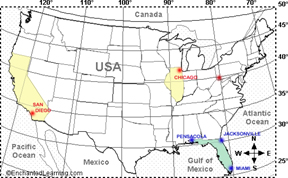
The Gulf of Mexico shore is blessed with larger bays such as Tampa Bay, Apalachicola Bay,
Charlotte Harbor,
and Pensacola Bay, all capable of becoming a major
deep water port. This abundance of rivers and harbors on the Gulf side makes
this coastal line long and diverse.
Florida has many rivers on the Gulf Coast,
centers of early habitation and transportation. The Atlantic side, however, has
Florida's largest river,the St. John's, one of
the world's few northward flowing streams. No state can match Florida's number of major springs. Boasting,
fishing, and swimming are words that have long been associated with Florida.
And yet, many urban areas of Florida face
severe water shortages, a fact that is confusing to the outsider who examines Florida's water resources.
Some Key Florida Facts Exposed
FLORIDA IS VERY WEST
Pittsburgh is further EAST than Tallahassee. When you go to Pensacola you are almost as far west as Chicago.
FLORIDA IS VERY SOUTH
The northernmost point in Florida is 100 miles futher south then the southernmost point in California. Only Hawaii is further south than Florida.
FLORIDA IS MUCH BIGGER THAN IT LOOKS ON A MAP.
If yopu drive by car from Fernandia Beach to Key West and then to Pensacola, you will have driven the distance from Kansas City to New York City - about 1,300 miles.
If you drive from Key West to Dallas, Texas, you would spend 50% of the distance in Florida. And when you drive from Key West to New York City, 50% of your driving will be in one state - Florida.
Don't believe the Almanacs about sizew of area - if you add all of Florida's lakes (people live in houseboats), Florida becomes the largest state east of Mississippi River.
